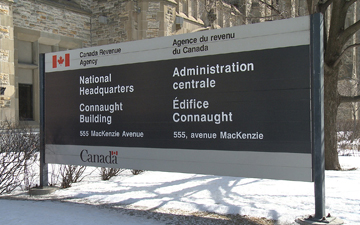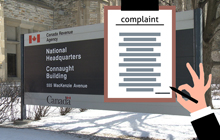Canadian taxpayers, beware: The CRA gets away with defective pleadings during tax litigation

In Canada v. Preston, the Federal Court of Appeal sided with the Canada Revenue Agency and overturned the Tax Court's decision, over the issue of assumptions
Introduction: Canada v. Preston, 2023 FCA 178
 |
David J Rotfleisch, CPA, JD is the founding tax lawyer of Taxpage.com and Rotfleisch & Samulovitch P.C., a Toronto-based boutique tax law corporate law firm. |
For the most part, in Canadian tax disputes, the Canada Revenue Agency may make factual assumptions — that is, assume the facts favouring the CRA's position without proving that those facts are true — and the taxpayer bears the initial burden of disproving the CRA's factual assumptions.
Because the taxpayer usually bears the burden of disproving the CRA's factual assumptions, the procedural rules of tax litigation require the CRA's pleadings to state the factual assumptions that the CRA made "when making the assessment." This requirement ensures that the taxpayer's lawyer knows exactly which factual assumptions to disprove in the Tax Court of Canada trial.
Of course, when issuing a tax assessment, the CRA must also apply Canada's tax laws and reach a legal conclusion. But these are legal arguments, not statements of fact. Thus, when listing the CRA's factual assumptions, the CRA's pleadings cannot include statements about legal conclusions or statements about mixed fact and law.
Yet in practice, the CRA's pleadings often mistakenly identify legal conclusions and statements of mixed fact and law as "assumptions of fact."
In Canada v. Preston, 2023 FCA 178, the Federal Court of Appeal considered this exact situation and decided that the CRA may sometimes get away with these defective pleadings. This decision means that Canadian taxpayers must carefully decide, with input from an experienced Canadian tax-litigation lawyer, whether there's anything to be gained from challenging the CRA's defective tax-litigation pleadings.
Canada v. Preston, 2023 FCA 178
The Preston case involved three taxpayers — two individuals and a trust. The individuals were non-resident beneficiaries of the Canadian-resident trust. The beneficiaries, with the assistance of expert Canadian tax-planning lawyers, implemented a tax plan to avoid the $12 million in capital-gains tax that would otherwise have resulted from the 21-year deemed-disposition rule.
Subsection 104(4) of Canada's Income Tax Act deems a trust to have disposed of all its capital property at fair market value every 21 years. This deemed disposition causes the trust to realize capital-gains tax every 21 years. Knowledgeable tax-planning lawyers have devised several tax-planning strategies to avoid or defer the trust's capital-gains tax resulting from the 21-year deeming rule.
One tax strategy is for the trust to distribute its assets (just before the 21 years expires) to its beneficiaries under the trust-specific tax-rollover rule under subsection 107(2) of Canada's Income Tax Act. This trust-specific tax-rollover rule applies only if the beneficiary receiving the trust assets is a Canadian tax resident. If the trust distributes its assets to a non-resident beneficiary, it triggers a deemed disposition at fair market value, thereby triggering capital-gains tax for the trust.
This obviously posed a problem for the non-resident beneficiaries in the Preston case. To deal with this problem, their lawyers implemented a tax reorganization whereby the non-resident beneficiaries became the sole shareholders of an Alberta unlimited liability company (ULC )— which, by virtue of being incorporated in Canada, is deemed to be a Canadian tax resident.
The non-resident beneficiaries then assigned their capital interests in the trust to the Alberta ULC under the section 85 tax-deferred rollover. This meant that the Alberta ULC, a Canadian tax resident, was now the sole beneficiary of the Canadian trust, and that the trust distribution would now qualify for the trust-specific tax-rollover rule under subsection 107(2) of Canada's Income Tax Act. The Canadian trust accordingly distributed its capital assets to the Alberta ULC and avoided the capital-gains tax resulting from the 21-year deeming rule.
After initiating a tax audit, the CRA disputed the legitimacy of the tax reorganization. In particular, the CRA tax auditor alleged that, despite the assignment, the Alberta ULC never became the trust's beneficiary, and that the two non-resident individuals had remained the trust's beneficiaries throughout. So, according to the CRA, the trust distributed its property to the non-resident individuals, not to the Canadian-resident ULC. The CRA then assessed the trust for over $12 million in capital-gains tax.
The taxpayers' Canadian tax-litigation lawyer disputed the CRA's $12 million tax assessment by filing a notice of appeal to the Tax Court of Canada after the CRA rejected the taxpayers' notice of objection.
In response, the CRA filed a reply to the notice of appeal. As required by the Tax Court's procedural rules, Tax Court of Canada Rules (General Procedure), the CRA's reply listed the factual assumptions underlying the CRA's decision to reassess. The list included the following five statements:
- "On September 25, 2014... the fair market value of the [property] received by Mr. and Mrs. Preston was $75,511,267, comprised of the [fair market value] of the Holdco shares of $67,979,759 and the [fair market value] of the Partnership interest of $7,531,508."
- "At all material times, the [Trust's] beneficiaries were Mr. Preston, Mr. Preston's spouse (Ms. Preston), and Mr. Preston's issue."
- "The [Trust's] beneficiaries could only be natural persons."
- "The [Trust's] beneficiaries could not be corporations."
- "After the Assignment, Mr. and Ms. Preston remained the income and capital beneficiaries of the [Trust]."
- "ULC was not a beneficiary of the [Trust]."
The taxpayers' lawyer filed a motion asking the Tax Court of Canada to strike these statements (i.e., delete them) from the CRA's reply. At the motion hearing, the taxpayers' Canadian tax-litigation lawyer contended that these statements weren't factual assumptions but legal conclusions. These legal conclusions, argued the taxpayers' tax lawyer, don't identify any factual allegations, which can be proved or disproved, and they therefore "do not enable the [taxpayer] to know the case to be met."
The Tax Court of Canada agreed, finding that all six statements constituted legal conclusions, and that not a single one was a factual statement that the CRA could assume for the purposes of tax litigation. Yet rather than deleting the CRA's pleadings outright, the Tax Court permitted the CRA to file an amended reply remedying the defective pleadings.
The CRA opted instead to appeal the Tax Court's decision to Canada's Federal Court of Appeal. Appearing before the Federal Court of Appeal, the CRA maintained that the Tax Court's decision had run afoul of subsection 53(1) of the Tax Court of Canada Rules (General Procedure). This provision gives the Tax Court of Canada the discretion to strike out any portion of a party's pleadings if those pleadings "may prejudice or delay the fair hearing of the appeal" or are "an abuse of the process of the [Tax] Court." According to the CRA's lawyer, the Tax Court contravened subsection 53(1) by rendering its decision without considering whether the CRA's pleadings had "prejudiced or delayed" or had "abused" the proceedings.
Canada's Federal Court of Appeal sided with the CRA and overturned the Tax Court's decision. The appellate court found that the Tax Court had erred by failing to apply the test in subsection 53(1) of the Tax Court of Canada Rules (General Procedure):
Moreover, while the Tax Court assumed the respondents relied on Rule 53(1)(a), it did not then consider whether the assumptions, if retained as such, would be prejudicial or delay the fair hearing of the appeal. [...] Rule 53(1) contains the test for striking out pleadings and the Tax Court did not apply that test, and so erred in law. [paras 17-18]
The Federal Court of Appeal also suggested that the Tax Court had seemingly adopted a mistaken view of the significance of the purported assumptions appearing in the CRA's pleadings:
[I]t is evident that the Tax Court concluded that no statement of mixed fact and law can stand as an assumption. [...] I disagree. There is no principle of law that a statement of mixed fact and law cannot stand as an assumption. [paras 17-18]
Notably, in this case, the Tax Court's order did not strike out the assumptions; it merely ordered them moved to another part of the replies. The only inference that can be drawn is that the Tax Court concluded that leaving them as assumptions placed an onus on the respondents that they would not otherwise bear. But that is not so. [para 19]
An assumption that is a statement of mixed fact and law does not put any additional onus on the taxpayer. This is clear.
As explained in Goldman v. Minister of National Revenue, [...] "when the validity of the assessment is attacked in point of law...there is really no onus on either party, for once the facts have been established, the responsibility for determining the validity of the assessment as a matter of law is solely that of the court." [...]. As observed in Kopstein, "[i]n assessing whether it is appropriate to strike a paragraph...one must bear in mind the practical effect of the paragraph" and "an invalid or irrelevant assumption does not cast an onus on [a taxpayer] just because it was pleaded" [...]. [para 20]
The appellate court also observed that, because the parties had demonstrated that they understood each other's positions, the taxpayer suffered no prejudice as a result of the CRA's defective pleadings:
The [taxpayers] complain that unless the facts are extricated from the statements of mixed fact and law, they do not know the case they have to meet. But that is clearly not so. Reading the notices of appeal, the replies and the answers, there is no doubt where the issues lie and what is in dispute. Indeed, the parties seem to largely agree about what happened; the dispute centers on the consequences. [para 21]
According to the court, the CRA's defective pleadings may still be allowed "to stand if, for example, the facts are relatively simple, there is little or no debate about the applicable legal principles, or there is little risk that the [taxpayer] will be prejudiced or will be obligated to waste resources." The Federal Court of Appeal went on to state that, "before striking out a pleading [concerning the Canada Revenue Agency's assumptions], the Tax Court must consider whether it is appropriate to do so in the circumstances having regard to [...] whether there is risk of prejudice or delay in the fair hearing of the appeal if the assumption is permitted to stand."
The appellate court reasoned that, in this case, the Tax Court's decision would have delayed proceedings, not expedited them, as the procedural rules required:
While in some circumstances it will be appropriate to strike out an assumption that is a statement of mixed fact and law, that is not universally the case. In each case, the Tax Court must balance the consequences of letting the assumption stand against the consequences of striking it out. It must consider not only the conditions in Rule 53, but also what is in the best interests of the trial process given the need to facilitate the just, most expeditious and least expensive determination of the dispute. [para 82]
In this case, rather than consider whether the [taxpayers] demonstrated a risk of prejudice or delay, or whether its order served the interests of the trial process, the Tax Court decided that any assumption that is a statement of mixed fact and law should be struck out and moved to the reasons. In my view, this served no useful purpose in the context of these appeals. The notices of appeal were filed more than three years ago, and the answers more than two years ago, shortly before the respondents brought their motions. Ironically, here, the only consequence of the Tax Court's decision is to further delay proceedings in the Tax Court — a factor that instead should have weighed against granting the [taxpayers'] motions in the circumstances. [para 83]
As a result, the Federal Court of Appeal allowed the CRA's appeal, overturned the Tax Court's decision, and permitted the CRA to retain all the assumptions as they had appeared in the CRA's original reply.
Does the Preston decision raise the burden on taxpayers?
As we mentioned above, in Canadian tax disputes, the taxpayer usually bears the burden of disproving the CRA's factual assumptions. The procedural rules of tax litigation require the CRA's pleadings to state the factual assumptions but, in practice, the CRA's tax-litigation pleadings often mistakenly identify legal conclusions and statements of mixed fact and law as "assumptions of fact." The Federal Court of Appeal's Preston decision suggests that the CRA can get away with these defective pleadings.
Does this decision raise the burden on taxpayers, forcing them to also disprove the legal conclusions that the CRA's pleadings incorrectly describe as "assumptions of fact"?
In principle, no. On the surface, it may appear that the Federal Court of Appeal allowed the CRA to plead legal conclusions as factual assumptions that the taxpayer bears the onus of disproving. But that's not what the court did. The court acknowledged that the CRA's pleadings were defective, precisely because they listed legal conclusions in the section that should have been devoted to factual assumptions.
But this error is one of mere formality: Legal conclusions appeared in the wrong section of the pleadings. And a formal error such as this doesn't alter the burden of proof in tax cases. The Preston decision therefore doesn't entail that taxpayers now bear a burden of disproving legal arguments just because they appear in the wrong section of the CRA's pleadings.
Yet, as a practical matter, Canadian taxpayers will generally be incapable of distinguishing between genuine factual assumptions, which the taxpayer must disprove, and legal conclusions that the CRA has incorrectly identified as factual assumptions.
David J Rotfleisch, CPA, JD is the founding tax lawyer of Taxpage.com and Rotfleisch & Samulovitch P.C., a Toronto-based boutique tax law corporate law firm and is a Certified Specialist in Taxation Law who has completed the CICA in-depth tax planning course. He appears regularly in print, radio and TV and blogs extensively.
With over 30 years of experience as both a lawyer and chartered professional accountant, he has helped start-up businesses, cryptocurrency traders, resident and non-resident business owners and corporations with their tax planning, with will and estate planning, voluntary disclosures and tax dispute resolution including tax audit representation and tax litigation. Visit www.Taxpage.com and email David at david@taxpage.com.
Read the original article in full on TaxPage. Author photo courtesy Rotfleisch & Samulovitch P.C. Title image: Unsplash.










(0) Comments